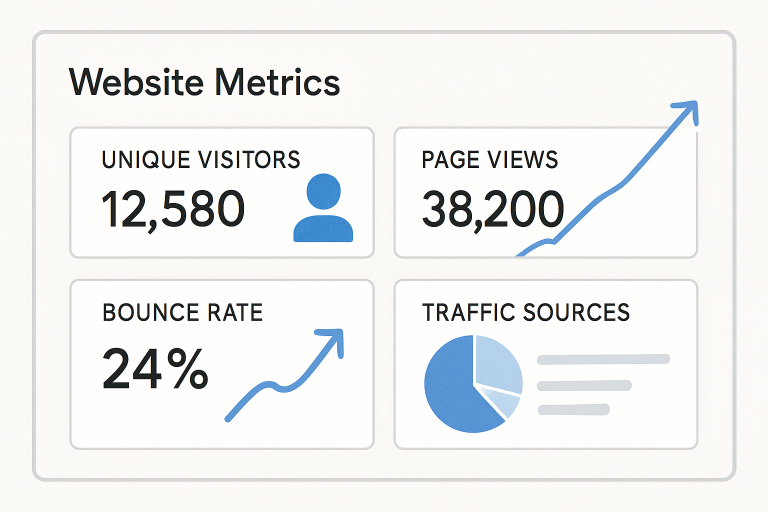Why Website Traffic Matters
Responsive digital decision-making starts with a deep understanding of website traffic. Who is visiting, where they come from, how long they stay, and what actions they take all provide invaluable insight into a site’s performance. Traffic patterns reveal consumer interests, highlight which content resonates—or falls flat—and help businesses spot conversion roadblocks. By creating a comprehensive measurement framework, organizations can optimize their websites for both usability and return on investment.
To truly evolve your digital strategy, you need practical tools that do the heavy lifting and deliver precise, actionable data. Many organizations opt to analyze website traffic with Vazoola for reliable reporting and robust analytics, transforming raw data into actionable insights for growth and engagement. These insights inform everything from content planning to user experience enhancements, ensuring that efforts are aligned with real-world behavior.
What To Measure When Analyzing Traffic
- Unique Visitors: The foundation of web analytics, showing how many individuals visit your site in a specific timeframe. It’s vital for tracking growth and the reach of marketing campaigns.
- Page Views: This metric tracks the number of times any page is loaded, providing insights into what topics drive repeat visits and what content may need improvement.
- Bounce Rate: A high bounce rate could indicate that visitors aren’t finding what they expect or there are technical issues, highlighting an urgent need for investigation.
- Traffic Sources: Breaks down how people arrive at your site, whether from search, referrals, direct entries, or social media. Knowing this helps focus your marketing spend on the most productive channels.
- Session Duration: Tells you how long visitors stay on your site—longer times usually signal better engagement or a smoother flow of content.
Mastering these metrics allows you to calibrate your site, personalize content, and refine marketing campaigns with precision.
Reliable Sources Of Traffic Data
Website owners have access to a range of tools for harvesting traffic insights—including Google Analytics, Matomo, built-in CMS dashboards, and more specialized platforms. Each tool may process and visualize data in a slightly different way, but the goal is always the same: robust accuracy and actionable advice. The choice of source depends on your technical ecosystem, privacy needs, and business objectives.
Choosing The Right Web Analytics Tool
Selecting an analytics tool isn’t just about price—it’s about matching features and usability to your unique business requirements. Free options like Google Analytics offer deep data, but sites with complex needs often outgrow them. Premium analytics platforms step up with advanced segmentation, real-time reporting, seamless integrations, and data export options ideal for organizations prioritizing customization or growth.
- Look for intuitive interfaces that make insights easy to access for every team member.
- Ensure your chosen platform is compliant with regulations like GDPR and CCPA.
- Strong data visualization is key to clear communication between technical and non-technical stakeholders.
- Pay attention to the ability to integrate with your marketing stack—automation, email, advertising, and CRM tools included.
Many digital leaders recommend trialing multiple platforms before making a long-term commitment to ensure a snug fit with your analytics workflow.
How To Benchmark Your Website Traffic
Numbers mean little without context. By benchmarking your website against comparable sites in your industry, location, and market size, you gain clarity on exactly where you stand. Resources like market research reports and tools from respected digital intelligence firms can help identify whether your traffic is trending above, below, or at industry standard. This context drives smarter experimentation and resource allocation, helping you better compete in your sector.
Emerging Trends In Website Traffic Analysis
The world of analytics is quickly evolving. Tighter privacy rules, such as the GDPR and CCPA, are reshaping how data can be gathered, prompting platforms to adopt greater transparency and obtain user consent. Meanwhile, AI-driven tools and predictive analytics are enabling companies to uncover insights and forecast trends with unprecedented accuracy. Cookieless tracking and server-side data collection are gaining traction, enabling businesses to remain informed while respecting user privacy. As these dynamics shift, staying current on analytics innovation is more important than ever.
Actionable Steps For Smarter Digital Decisions
- Set Clear Goals: Determine what you aim to achieve from your analytics before investing in new tools or tactics.
- Select The Right Tools: Take advantage of free trials and demos to understand which platform best meets your needs.
- Schedule Regular Reviews: Make it a habit to check traffic reports at least monthly and react to emerging patterns promptly.
- Benchmark Against Peers: Compare key metrics with industry standards rather than focusing solely on your own historical data.
- Test, Learn, Iterate: Embrace experimentation—digital best practices are always evolving, as are your audience’s preferences.
Informed, agile analysis of your website traffic is not just a technical task—it’s a competitive advantage. Begin with clear goals, leverage the most suitable tools, and integrate continuous improvement across every level of your digital operation. By applying these core strategies, your website will be primed for growth and sustained digital success.
Conclusion: Turning Traffic Insights into Growth
Website traffic is more than just a set of numbers; it’s a window into your audience’s behavior, preferences, and needs. By understanding who visits your site, how they engage, and where improvements are needed, businesses can make smarter, data-driven decisions. Leveraging the right analytics tools, benchmarking performance, and staying ahead of emerging trends ensures that every digital effort is purposeful and effective. Ultimately, mastering website traffic transforms raw data into actionable strategies, fueling sustained growth, better user experiences, and measurable business results.
